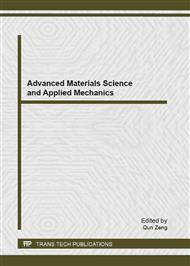p.145
p.149
p.154
p.159
p.167
p.172
p.176
p.181
p.186
Synthesis and Characterization of Antimony Doped Tin Oxide Conductive Nanoparticles by Alkoxide Hydrolysis Method
Abstract:
Antimony doped tin oxide (ATO) conductive nano-particles are synthesised by alkoxide hydrolysis method using SnCl4•5H2O and SbCl3 as raw materials. The optimum parameters are determined as: Sb3+ doped molar concentration 15%, reaction temperature 60°C and roasting temperature 600°C. Under optimum conditions, the synthesised nano-particles are characterized by means of X-ray diffraction (XRD) and transmission electron microscope (TEM). XRD results show that all Sb ions came into the SnO2 lattice to substitute Sn ions. The image of TEM shows the ATO conductive nano-particles average size is 5 nm. Volume resistivity lowest value of ATO nano-particles is 141 Ω•cm.
Info:
Periodical:
Pages:
167-171
Citation:
Online since:
May 2013
Authors:
Price:
Сopyright:
© 2013 Trans Tech Publications Ltd. All Rights Reserved
Share:
Citation:


